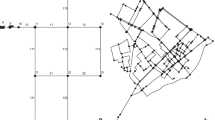Abstract
A new methodology was proposed for contamination source identification using information provided by consumer complaints from a probabilistic view. Due to the high uncertainties of information derived from users, the objective of the proposed methodology doesn’t aim to capture a unique solution, but to minimize the number of possible contamination sources. In the proposed methodology, all the possible pollution nodes are identified through the CSA methodology firstly. And then based on the principle of total probability formula, the probability of each possible contamination node is obtained through a series of calculation. According to magnitude of the probability, the number of possible pollution nodes is minimized. The effectiveness and feasibility of the methodology is demonstrated through an application to a real case of ZJ City. Four scenarios were designed to investigate the influence of different uncertainties on the results in this case. The results show that pollutant concentration, injection duration, the number of consumer complaints nodes used for calculation and the prior probability with which consumers would complaint have no particular effect on the identification of contamination source. Three nodes were selected as the most possible pollution sources in water pipe network of ZJ City which includes more than 3 000 nodes. The results show the potential of the proposed method to identify contamination source through consumer complaints.
Similar content being viewed by others
References
CRISTIANA D C, LEOPARDI A. Pollution source identification of accidental contamination in water distribution networks [J]. Journal of Water Resources Planning and Management, 2008, 134(4): 197–202.
HUANG J J, MCBEAN E A. Data mining to identify contaminant event locations in water distribution systems [J]. Journal of Water Resources Planning and Management, 2009, 135(6): 466–474.
SHANG Feng, UBER J G, POLYCARPOU M M. Particle backtracking algorithm for water distribution system analysis [J]. Journal of Environmental Engineering, 2002, 128(5): 441–450.
LAIRD C D, BIEGLER L T. A mixed index approach for obtaining unique solutions in source inversion of drinking water networks [C]// The World Water & Environmental Resources Congress, EWRI, Anchorage, Alaska, 2006: 16–25.
PREIS A, OSTFELD A. Contamination source identification in water systems: A hybrid model trees-linear programming scheme [J]. Journal of Water Resources Planning and Management, 2006, 132(4): 263–273.
LIU L, RANJITHAN S R, MAHINTHAKUMAR G. Contamination source identification in water distribution systems using an adaptive dynamic optimization procedure [J]. Journal of Water Resources Planning and Management, 2011, 137(2): 183–192.
GUAN Jia-bao, ARAL M M, MASLIA M L, GRAYMAN W M. Identification of contamination sources in water distribution system using simulation-optimization method: Case study [J]. Journal of Water Resources Planning and Management, 2006, 132(4): 252–262.
KUMAR J, BRILL E D, MAHINTHAKUMAR G, RANJITHAN R J. Identification of reactive contamination sources in a water distribution system under the conditions of data uncertainties [C]// World Environmental and Water Resources Congress, Tucson, Arizona, 2010: 135–145.
DAWSEY W J, MINSKER B S, VANBLARICUM V L. Bayesian belief networks to integrate monitoring evidence of water distribution system contamination [J]. Journal of Water Resources Planning and Management, 2006, 132(4): 234–241.
PETER J F. Expert knowledge and its role in learning Bayesian networks in medicine: An appraisal [M]. Nijmegen: AIME, 2001: 156–166.
NILSSON J J, BUCHBERGER M G, CLARK N C. Simulating exposures to deliberate intrusions into water distribution systems [J]. Journal of Water Resources Planning and Management, 2005, 131(3): 228–236.
ALLMANN T P, CARLSON, ALICS K L. Modeling intentional distribution system contamination and detection [J]. J Am Water Works Assoc, 2005, 97(1): 58–61.
ROSSMAN L A. EPANET 2.0 users manual [M]. Cincinnati: National Risk Management Research Laboratory, 2000: 40–41.
SANCTIS A E D, SHANG Feng, UBER J G. Real-time identification of possible contamination sources using network backtracking methods [J]. Journal of Water Resources Planning and Management, 2009, 132(5): 301–311.
EPANET 2.0. Toolkits. (2000). [EB/OL]. [2011-02-11]. www.epa.gov/ORD/NRMRL/wswrd/epanet.html.
DAVIS M J, ROBERT J. Importance of exposure model in estimating impacts when a water distribution system is contaminated [J]. Journal of Water Resources Planning and Management, 2008, 134(5): 449–455.
Author information
Authors and Affiliations
Corresponding author
Additional information
Foundation item: Project(50908165) supported by the National Natural Science Foundation of China
Rights and permissions
About this article
Cite this article
Tao, T., Huang, Hd., Xin, Kl. et al. Identification of contamination source in water distribution network based on consumer complaints. J. Cent. South Univ. Technol. 19, 1600–1609 (2012). https://doi.org/10.1007/s11771-012-1182-3
Received:
Accepted:
Published:
Issue Date:
DOI: https://doi.org/10.1007/s11771-012-1182-3




